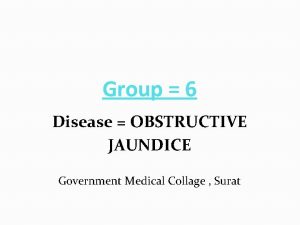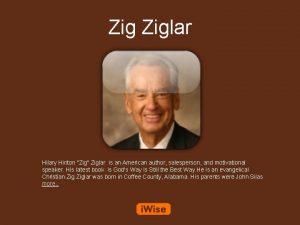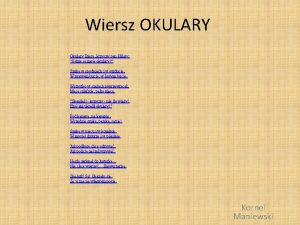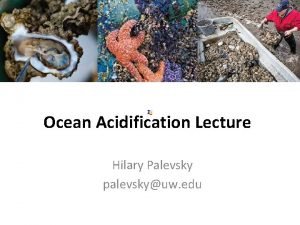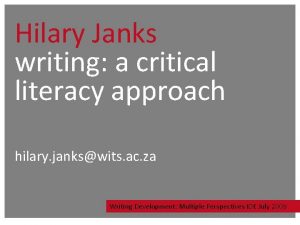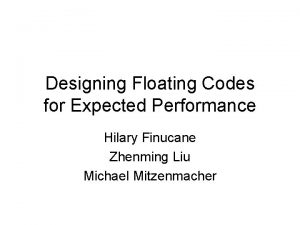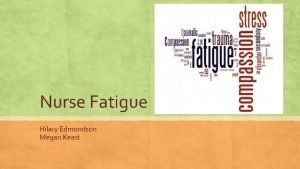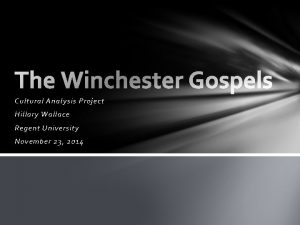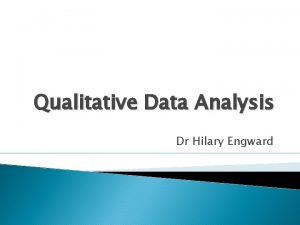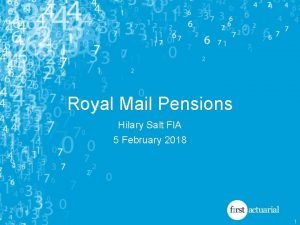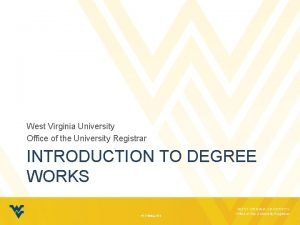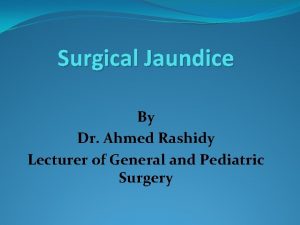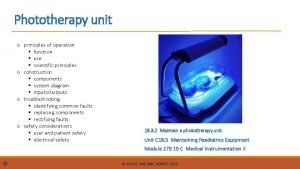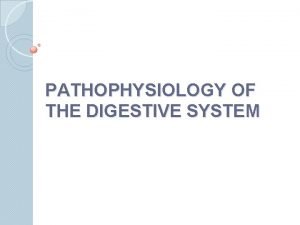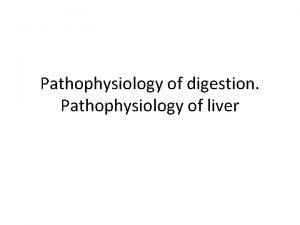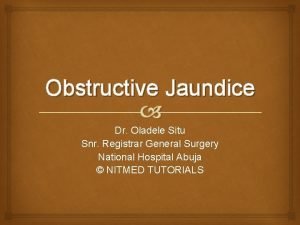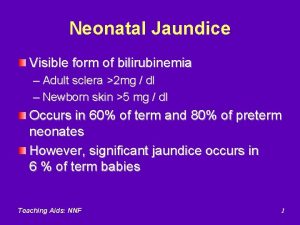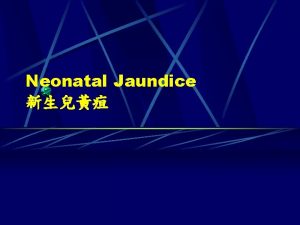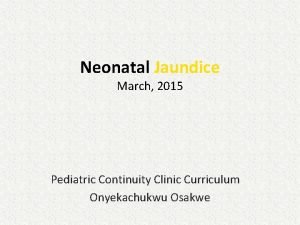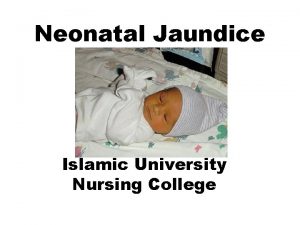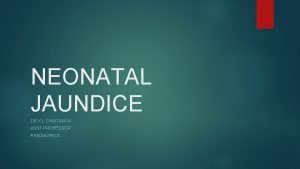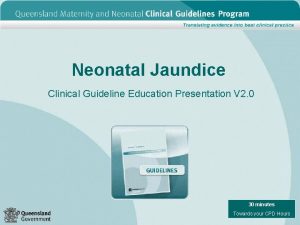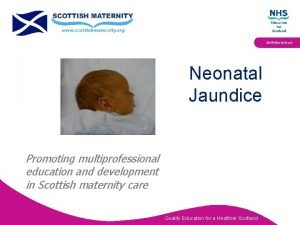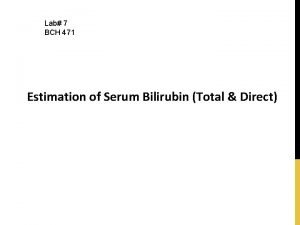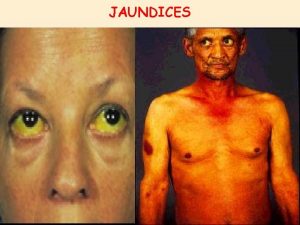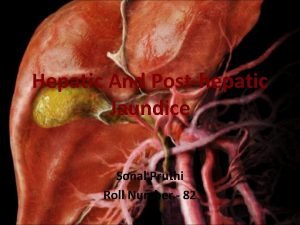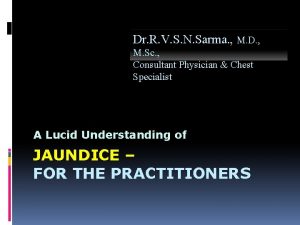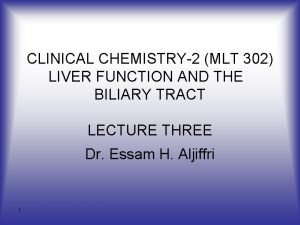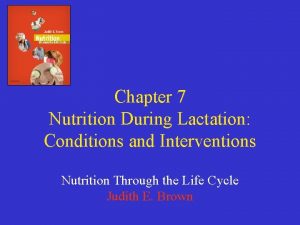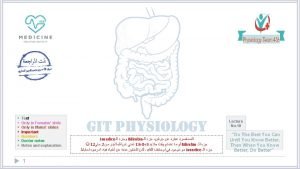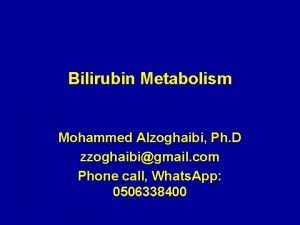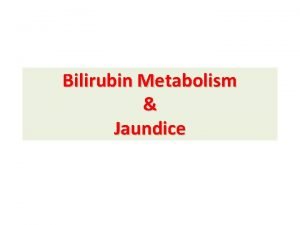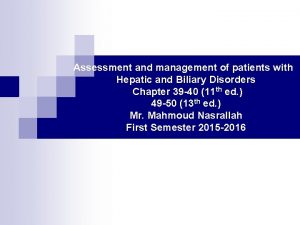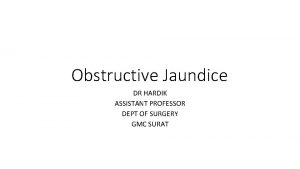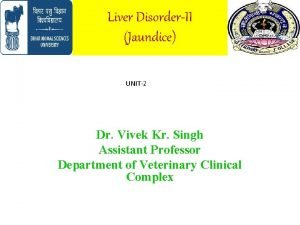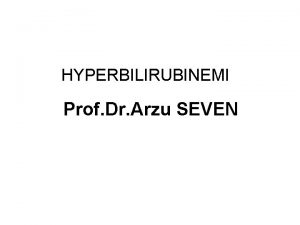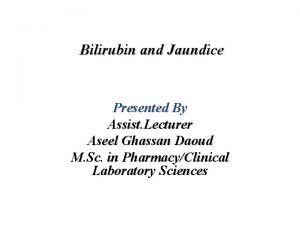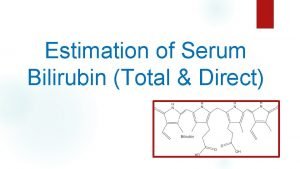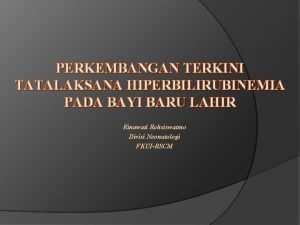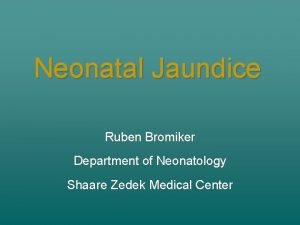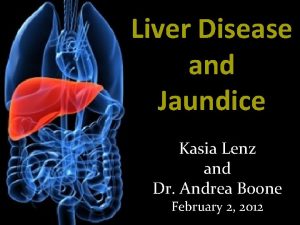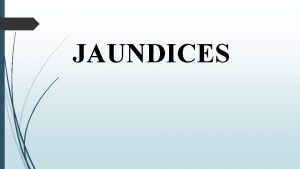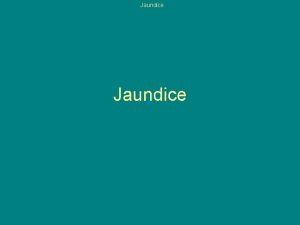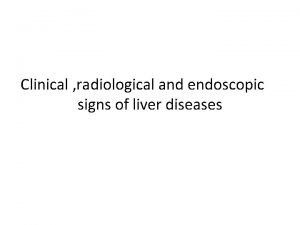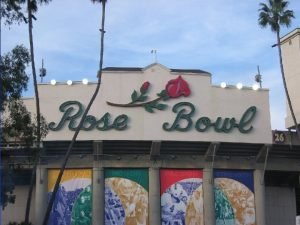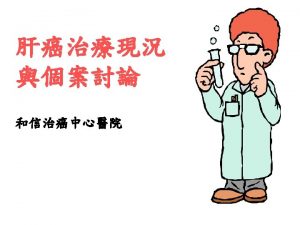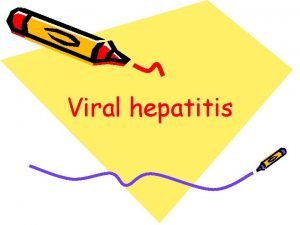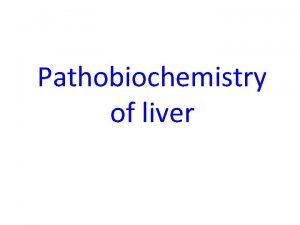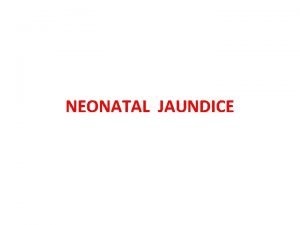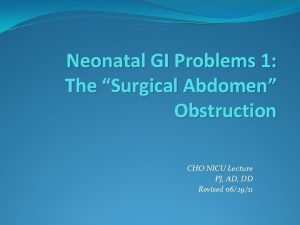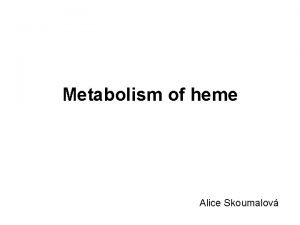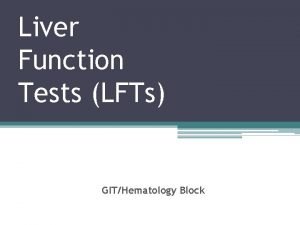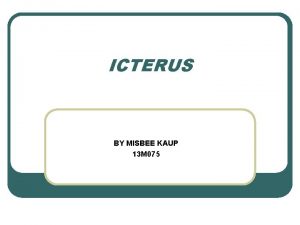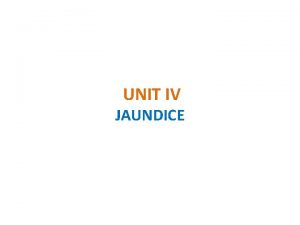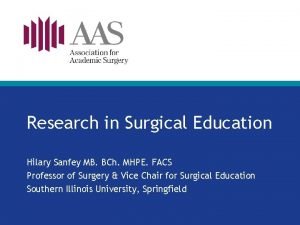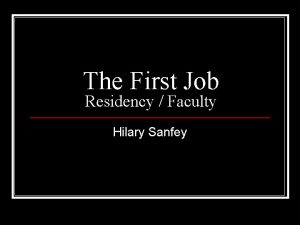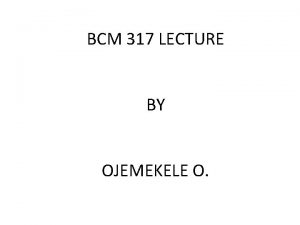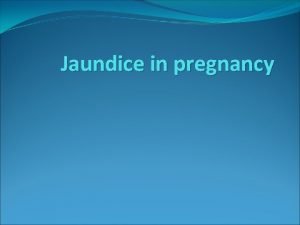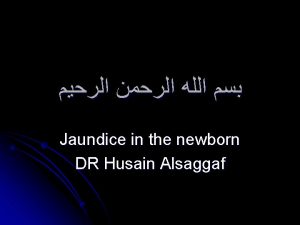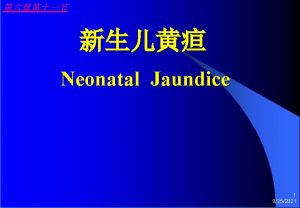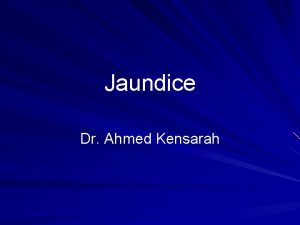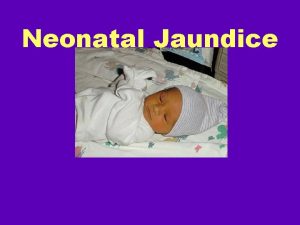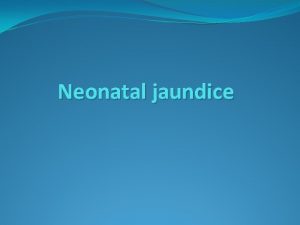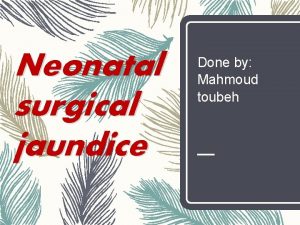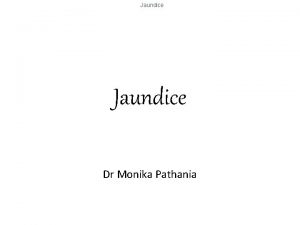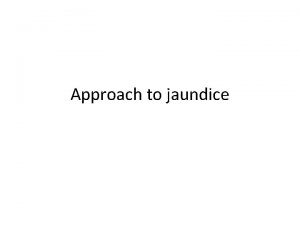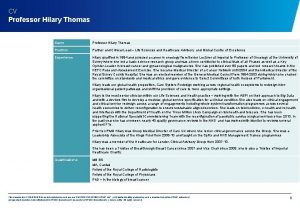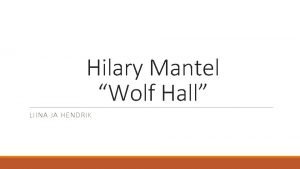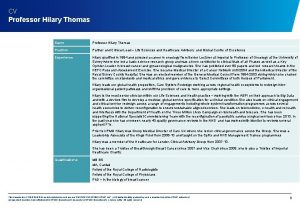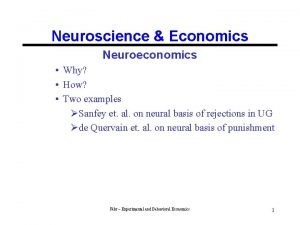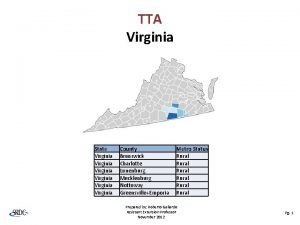Jaundice Hilary Sanfey MD University of Virginia Mrs



































































- Slides: 67

Jaundice Hilary Sanfey, MD University of Virginia

Mrs. J. S. § Your patient in the ER is a 55 year-old female with a short history of upper abdominal discomfort and chills. Her family noticed she was jaundiced.

What other points of the history do you want to know?

History § Focused HPI and relevant symptoms § Medications particularly those associated with liver damage e. g. fluconazole, acetaminophen § Alcohol use § I. V. drug use § History of biliary surgery and/or malignancy § Previous transfusions / pregnancies § Occupational exposure e. g. to solvents

History, Patient J. S. Consider the following: § Characterization of symptoms § Temporal sequence § Alleviating / Exacerbating factors: § Associated signs/symptoms § Pertinent PMH § ROS § MEDS § Relevant Family Hx.

History Characterization of Symptoms Abdominal Discomfort • • Epigastric and right upper quadrant Radiating to back / shoulder Dull ache and increasing in severity Quantified as a 5/10 Chills • Shivering and unable to get warm Jaundice • Associated with pruritus, dark urine and pale stools

History Temporal sequence § Pain • • Started 3 -4 days prior to ER presentation Came on gradually and increased in severity Previous episodes but of lesser severity Some fatty food intolerance § Chills • Noticed 24 hours after onset of pain § Jaundice • Noticed by family on day of visit

History § Alleviating / Exacerbating factors: • None noted § PMH • • • MVA in 1985 received a blood transfusion Two children uneventful pregnancies Appendectomy 1970 § ROS • Non contributory § MEDS • Antacids (OTC) for “indigestion” which has been increasing in frequency

History § Relevant Family Hx. • Non relevant • Specifically no other family members have been jaundiced or ill § Social History • • Alcohol 6 -8 beers per weekend Smokes 1 pk/day for 25 years Home maker No recent shellfish ingestion

History § Associated signs/symptoms: • • • Pale stools Pruritus Nausea Anorexia Weight loss nil Chills

What is your Differential Diagnosis?

Differential Diagnosis Based on History and Presentation § Cholestatic (obstructive ) Jaundice • • • Cholangitis Cholecystitis Cholelithiasis / choledocholithiasis Benign or malignant biliary stricture Pancreatic or biliary tumor § Cholestatic liver disease • Primary Biliary Cirrhosis • Primary Sclerosing Cholangitis § Hepatocellular jaundice • Hepatitis B / C • Alcoholic cirrhosis • Metastatic liver disease

Physical Examination What would you look for?

Physical Examination What would you look for? § Vital signs § General examination should take note of the presence or absence of jaundice, excoriation, palmar erythema, spider nevae, or tremor § Focused physical examination should include examination of the abdomen for tenderness, masses, hepatosplenomegaly or ascites.

Physical Examination, Patient J. S. HEENT: NC Genital-rectal: NC Chest: NC Neuromuscular: NC CV: NC Breast: NC Remaining Examination findings non-contributory (NC)

Physical Examination. J. S. § Vital Signs: • Temp • HR • BP § Appearance: • • In mild distress Overweight Jaundiced Excoriation of skin 38. 9 100/min 110/80

Relevant exam findings for a problem focused assessment § Abdomen • • • Epigastric tenderness Mild distension Decreased bowel sounds No ascites or rebound No masses § Rectal exam • shows gray stool (Guaiac negative)

Would you like to revise your Differential Diagnosis?

Would you like to revise your Differential Diagnosis? § Primary liver disease is unlikely to cause jaundice in the absence of any stigmata of chronic liver disease. • • • Cholangitis Cholecystitis Cholelithiasis / choledocholithiasis Benign or malignant biliary stricture Pancreatic or biliary tumor

Laboratory What studies would you obtain?

Laboratory • CBC • Comprehensive metabolic panel (includes electrolytes and LFTs) • INR • Blood cultures

Lab Results, Patient J. S. HCT WBC 37% 16, 000 K/Ul (35 – 47) (4 -11) Sodium Potassium 142 MMol/L 3. 7 MMol/L (135 -145) (3. 5 -5. 0) Chloride CO 2 101 MMol/L 28 MMol/L (98 -107) (19 -27) INR 1. 6 (0. 0 -1. 2)

Lab Results, Patient J. S. T. Bilirubin Conjugated bili 14 mg / dl 10. 5 mg / dl (0. 02 -1. 2 mg/ dl) Alk phos AST 800 U/L 177 U/L (34 – 104 U/L) (13 – 39 U/L) ALT Amylase 195 U/L 208 IU/L (9 – 52 U/L) (50 – 200 IU/L) Lipase BUN 1. 5 IU/L 18 mg / dl (0 – 1. 5 I U/L) (7 – 25 mg / dl) Creatinine 1. 1 mg / dl (. 7 – 1. 3 mg / dl)

Lab Results, Discussion § Explain the significance of abnormalities in: • LFT’s • WBC • Amylase • INR

Lab Results Discussion § LFTS The elevation in conjugated bilirubin / total bilirubin / alkaline phosphatase is greater than the relative increase in ALT /AST in conditions that cause cholestasis / extra hepatic biliary obstruction. The converse is true in hepatocellular injury.

Lab Results § WBC An elevated WBC with left shift is consistent with infection or inflammation § Amylase / Lipase Many acute abdominal conditions produce a chemical hyperamylasemia. Elevated amylase in setting of normal lipase is unlikely to be acute pancreatitis § INR The PT (INR) may be prolonged in patients with obstructive jaundice due to malabsorbtion of Vitamin K

Interventions at this point?

Interventions at this point? § § § NPO I. V. fluids I. V. broad spectrum antibiotics Nasogastric tube if vomiting or distended Analgesia

Studies What further studies would you want at this time?

Studies, Patient J. S. Obstruction Series/Acute Abdominal Series etc. Flat/Upright Abdomen PA/Lat Chest Mammogram/US RUQ US Angiogram HIDA Scan OTHER: X CT Scan: Abd/Pelvis CT Scan: Other MRI PET SCAN Extremity Film Bone Scan US Pelvis MRCP

Studies – Results § Discussion of imaging study Ultrasound is the initial study of choice in most patients with suspected biliary disease. For gallstones the sensitivity and specificity are 95%. U/S can detect stones as small as 3 mm in diameter and is highly sensitive for detecting intra and extra hepatic biliary dilatation but not CBD stones.

Would a flat / upright abdominal film be of any assistance at this point?

A plain abdominal x-ray may be a useful screening tool to exclude other acute abdominal conditions However it will not be helpful in diagnosing gallstones since 80% of gallstones are not radiopaque

Ultrasound of Gallbladder with stones

Radiology § The ultrasound demonstrates: • • Multiple stones in gallbladder Gallbladder is thickened but not distended Intra hepatic and extra hepatic biliary dilatation The pancreas is not visualized Would you like to revise your Differential Diagnosis?

Revised Differential Diagnosis § § § Cholangitis Cholelithiasis / Choledocholithiasis Benign or malignant biliary stricture (distal CBD) § Pancreatic tumor

Blood Culture Findings § Preliminary gram stain shows gram positive cocci later demonstrated to be enterococcus sensitive to cefazolin and piperacillin / tazobactam (Zosyn).

What next? 1. 2. 3. 4. Additional Imaging? Endoscopy? OR? Other?

What next? ERCP vs. PTC

ERCP Dilated CBD

PTC

Advantages of ERCP vs. PTC § The ultrasound has shown dilatation of both intra and extra hepatic bile ducts suggesting a lesion in the distal CBD. Therefore an ERCP would be the procedure of choice § If the biliary dilatation was predominantly intra hepatic a PTC would be the procedure of choice as it will better define proximal biliary anatomy

ERCP Patient J. S

ERCP Findings § ERCP (Endoscopic Retrograde Cholangio. Pancreatography) demonstrates a stone in the common bile at the ampulla. A sphincterotomy is performed and the stone is extracted § What potential complications may occur after ERCP?

ERCP § Complication rate is 10% • Bleeding • Duodenal perforation • Pancreatitis § Success rate is 90%

Final Diagnosis § 1. Cholangitis secondary to § 2. Choledocholitiasis

What are ? § Charcot’s triad § Reynalds’s pentad § Triangle of Calot

ANSWERS § Charcot’s triad • Right upper quadrant pain • Jaundice • Fever / chills § Reynolds’s pentad In addition to the above triad the patient may have pus in the biliary tree “acute suppurative cholangitis” with • Hypotension • Mental confusion

Answers § Triangle of Calot § This is the three sided area bordered by the inferior margin of the liver, cystic duct and common hepatic duct. The cystic artery and right hepatic artery traverse this triangle

Further Management 24 hours after the ERCP the patient has improved LFTs and is now afebrile with a WBC of 12, 000. What next?

Further Management § Continue IV fluids § Continue IV antibiotics § Correct INR § What surgical procedure is indicated at this point?

Laparoscopic Cholecystectomy (vs. open cholecystectomy) is now the procedure of choice.

Why is rehydration with intravenous fluid of particular importance in the jaundiced patient?

Answer § To minimize the possibility of developing hepato-renal failure

Consent for Cholecystectomy § What are the critical elements of informed consent?

The following criteria are essential for consent to be considered informed: § Capacity to make a decision § Absence of Coercion § Inform patient re potential Complications and alternatives § Content of message (i. e. imparting knowledge or informing the patient)

When Discussing Potential Complications of Surgery Consider: § Anesthetic (medical ) complications • • Drug related Pneumonia M. I. D. V. T. § Complications of any operation • General e. g. bleeding • Incision related e. g. dehiscence / infection § Complications of this specific operation

Potential Complications Following Laparoscopic Cholecystectomy § Conversion to an operation (5%) § Trocar injury to major vessels or to the intestine § Biliary injury (3 -10%)

Frequently asked questions by patients undergoing lap chole. § Will I have a tube in my nose when I wake up? • Usually a nasogastric tube is not indicated post operatively § When can I drive ? • Generally two weeks after surgery if the patient no longer requires narcotics for pain. § When can I go back to work? • One – two weeks for a sedentary job, two to four weeks for physical labor

QUESTIONS ? Should patients with asymptomatic gallstones have an elective cholecystectomy? § Approximately two thirds of patients will remain symptom free after 20 years therefore the answer is “No” unless the patient has a calcified gallbladder (increased risk of malignancy) or is a diabetic (controversial), with an increased risk of infection

QUESTIONS ? In a jaundiced patient with an enlarged palpable gallbladder the most likely diagnosis is: § Choledocholithiasis § Carcinoma of the head of the pancreas Explain your answer

Courvoisier’s Law § “In the presence of jaundice a palpable gallbladder is unlikely to be due to stone” If the obstruction was due to stone, the thick walled gallbladder would probably not distend

Describe some common variations in biliary anatomy

Explain why patients with cholestatic jaundice have dark urine and pale stools

§ Cholestasis predominantly increases direct (conjugated) bilirubin but also indirect (unconjugated) bilirubin § Dark urine § Since direct bilirubin is water soluble bilirubinuria develops § Pale stools Biliary obstruction prevents passage of bile into the intestinal tract for deconjugation to urobilinogen, the compound responsible for the dark color of stool

QUESTIONS?

Acknowledgment The preceding educational materials were made available through the ASSOCIATION FOR SURGICAL EDUCATION In order to improve our educational materials we welcome your comments/ suggestions at: feedback. PPTM@surgicaleducation. com
 Obstructive jaundice lab diagnosis
Obstructive jaundice lab diagnosis They are mrs garcia and mrs castro
They are mrs garcia and mrs castro They are mrs garcia and mrs castro
They are mrs garcia and mrs castro Mrs. darling was ___________ of mrs. s.
Mrs. darling was ___________ of mrs. s. Seo northern virginia
Seo northern virginia Hilary hinton
Hilary hinton Wiersz pan hilary tekst
Wiersz pan hilary tekst Whiskey creek fish hatchery
Whiskey creek fish hatchery Bajka pan hilary zgubił okulary
Bajka pan hilary zgubił okulary Hilary neve
Hilary neve Hilary janks
Hilary janks Abecadło wiersz
Abecadło wiersz Hilary cotter
Hilary cotter Hilary finucane
Hilary finucane Hilary hanahoe
Hilary hanahoe Hilary edmondson
Hilary edmondson Hilary tanner
Hilary tanner Hilary duff filmy
Hilary duff filmy Dr hilary wallace
Dr hilary wallace Dr hilary carman
Dr hilary carman Hilary salt
Hilary salt Hilary cremin
Hilary cremin Wvu degree works
Wvu degree works Courvoisier law
Courvoisier law Phototherapy unit uses
Phototherapy unit uses Palmar erythema causes
Palmar erythema causes Pathophysiology of jaundice
Pathophysiology of jaundice Benjamin classification of obstructive jaundice
Benjamin classification of obstructive jaundice Jaundice levels chart
Jaundice levels chart Differential diagnosis of jaundice in pediatrics
Differential diagnosis of jaundice in pediatrics Ivig hyperbilirubinemia
Ivig hyperbilirubinemia Pathologic jaundice
Pathologic jaundice Jaundice grading in adults
Jaundice grading in adults Infant jaundice chart
Infant jaundice chart Pathologic jaundice
Pathologic jaundice Bilirubin production
Bilirubin production Post hepatic jaundice
Post hepatic jaundice Jaundice
Jaundice Post hepatic jaundice
Post hepatic jaundice Intrahepatic jaundice
Intrahepatic jaundice Prehepatic jaundice
Prehepatic jaundice Pathological jaundice newborn
Pathological jaundice newborn Bilirubin metabolism
Bilirubin metabolism Post hepatic jaundice
Post hepatic jaundice Bilirubin metabolism
Bilirubin metabolism Cholycystostomy
Cholycystostomy Courvoisier law
Courvoisier law Jaundice pathogenesis
Jaundice pathogenesis Choluric jaundice
Choluric jaundice Types of jaundice
Types of jaundice Normal range of bilirubin
Normal range of bilirubin After which activity must food handlers wash their hands?
After which activity must food handlers wash their hands? Tatalaksana hiperbilirubinemia neonatus
Tatalaksana hiperbilirubinemia neonatus Dermal zones of jaundice
Dermal zones of jaundice Maddrey score
Maddrey score Icteric color
Icteric color Urobilinogen pathway
Urobilinogen pathway Heamangioma
Heamangioma Jaundice case presentation
Jaundice case presentation Bclc stage 2020
Bclc stage 2020 Neonatal jaundice
Neonatal jaundice Hepatic sinusoids
Hepatic sinusoids Indirect bilirubin increase causes
Indirect bilirubin increase causes Gas-filled bowel loops in abdomen meaning
Gas-filled bowel loops in abdomen meaning Types of jaundice
Types of jaundice Jaundice types
Jaundice types Causes of icterus
Causes of icterus Icterus
Icterus
